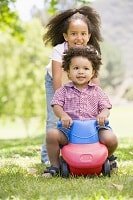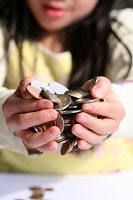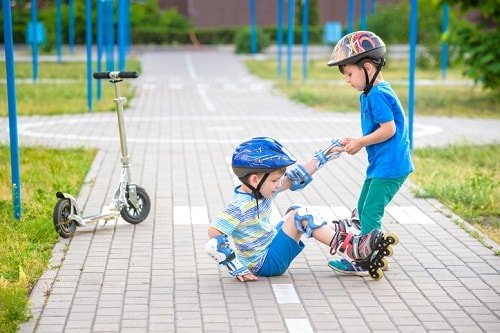© 2020 Gwen Dewar, Ph.D., all rights reserved
How do you teach kids to be helpful? To be generous and kind? Studies suggest we should avoid heavy-handed tactics and bribes. Instead, we need to respect — and nurture — our children’s natural inclinations to do good.
Helpful? Generous? Caring? Psychologists call these behaviors “prosocial,” and they are valued in societies throughout the world. Prosocial behavior is the bedrock of morality. It’s the glue that keeps communities strong.
And prosocial behavior is crucial for an individual’s success. Making friends, entering into cooperative projects, building trust and goodwill… all of these things depend on our ability to contribute, help, and share.
No wonder, then, that societies around the world strive to nurture or teach helpfulness. But which approaches are the most effective?
I think it’s crucial to start with an understanding of the psychology of prosocial behavior.
Children–even babies–can be spontaneously kind and helpful. They are prompted by a sense of empathy, and by the good feelings that arise from prosocial acts.
We can try to boost these natural inclinations, but beware. Pressuring children can backfire.
So let’s begin by considering this fundamental evidence, and then take a look at positive steps we can take to nurture helpfulness in children.
Experimental evidence: Children — even babies — can be spontaneously kind and helpful.
Some people believe that babies don’t experience empathy, but that’s wrong. As I explain elsewhere, babies respond to our emotional states.
If we’re stressed out, they become stressed too. If they see that we’re sad or dejected, their faces register sympathetic concern.
If they witness acts of bullying, they show a preference for the victims — and also for individuals who come to the aid of victims.
So yes, babies show signs of empathy — even before they can walk or talk.
And once babies start walking, they can use their motor skills to be helpers. Indeed, babies can recognize other people’s frustrated intentions and respond with a helping hand.
How can we be sure?
At the Max Planck Institute for Evolutionary Anthropology, Felix Warneken and Michael Tomasello tested 14-month-old babies by presenting them with a stranger experiencing difficulties.
The man was trying to pick up an object beyond his reach. Without even being asked, babies helped him retrieve it, and these kids were fast:
In most cases, the babies responded within 7 seconds—before the man made eye contact or named the object he was after (Warneken and Tomasello 2007).
Experiments on 18-month old babies yielded similar results (Warneken et al 2007). Babies helped a woman retrieve an out-of-reach item (a marking pen) even though they had to cross several obstacles first.
By the preschool years, kids become capable of even more sophisticated forms of aid, like helping a stranger get the attention of another person (Beier et al 2013), and giving people what they really need, instead of what they ask for (Martin and Olsen 2013; Hepach et al 2019).
Experimental evidence: Children help because it feels good.

This is crucial to understand. People like to be helpful. And young children are no different.
Experiments suggest that 22-month-old babies feel happy when they give to others (Aknin et al 2012).
Given a choice between sharing and hoarding, preschoolers show greater happiness when they share (Wu et al 2017).
And by the age of 3 to 6 years, kids are aware that sharing makes them feel good. They anticipate positive feelings, and this prompts them to be generous (Paulus and Moore 2017).
Experimental evidence: Kids are less likely to share if, in the past, adults have pressured them.
A few years back, Nadia Chernyak and Tamar Kushnir (2013) wondered what would happen if children were compelled to give away a prize. Would the experience encourage future generosity, or curtail it?
In experiments on 72 young children, aged 3-5, the researchers gave each child a sticker, and then introduced a sad character (a puppet) who needed cheering up. Some kids were told to give their sticker to the character. Other kids were given a choice.
Later kids were given three stickers, and presented with an opportunity to help yet another depressed creature.
Kids in both groups gave away at least one sticker. But some gave away two or three, and these were primarily the children who’d experienced free choice.
Kids who’d previously been forced to give were only half as likely to donate most of their stickers.
Why does forced sharing make children less likely to share spontaneously? One likely theory is that it disrupts the learning process.
When researchers have pitted spontaneous sharing against forced sharing, they noticed something. Kids don’t experience the same, natural high when they are forced to share (Wu et al 2017).
Thus, forced sharing may prevent kids from learning to associate sharing with positive feelings.
Experimental evidence: Giving kids prizes and toys for helping isn’t such a good idea.

Controlled studies have tested this hypothesis. For example, consider the research on toddlers.
Felix Warneken and Michael Tomasello (2008) assigned 20-month-old toddlers to one of three treatment groups.
- One group was trained to expect a material reward for helping.
- Another group was trained to expect verbal praise.
- The third group received no reward at all.
Next, the toddlers were given the opportunity to help an adult stranger. The outcome?
Compared to the kids in the “verbal praise” and “no reward” conditions, the kids with a history of tangible rewards became less likely to help.
A second experiment on somewhat older children — 3-year-olds — came up with similar results. Little kids end up sharing less after they’ve experienced bribes (Ulber et al 2016).
And there’s evidence regarding school-aged children, too.
In an experiment conducted by Richard Fabes and colleagues, primary school kids (grades 2-5) were offered the chance to sort stacks of colored paper (Fabes et al 1989).
All the kids were told this task would benefit hospitalized children.
In addition, some kids were also told that they would be given a small toy in exchange for helping.
After their initial opportunity to help, kids were given a second chance to work more on the same task. This time, there was no mention of the hospital kids or the material reward. Kids were simply given the change to spontaneously continue their “volunteer work.”
What happened?
The kids who had been given toys for helping were less helpful during the follow-up opportunity. They spent less time sorting paper and got less work done.
Moreover, the results were linked with parenting. Motivation was most undermined among kids whose parents routinely used tangible rewards at home (Fabes et al 1989).
Experimental evidence: Money — and talk about money — turns off the helpful, generous impulse.

As a team of Polish and American researchers explain, there are different modes for satisfying our needs.
One is by dealing with people in the marketplace. We buy and sell our services.
Another is by relating to each other out of a sense of community, friendship, or affection. We don’t help because we anticipate payment. We help because we care.
What happens when our attention turns toward the marketplace mode? The results aren’t good for prosociality. When researchers primed young children to think about money (by having them handle coins), the kids showed less helpfulness and generosity immediately after (Gasiorowska et al 2019).
So what positive steps can we take to encourage prosocial behavior?
Here’s what the research suggests.
1. Nurture empathy and “emotional intelligence”
Helpfulness in children is associated with many of the same factors that predict empathy and empathic concern (Eisenberg et al 2006; Brownell et al 2013), and that makes sense: Empathy makes us better at helping. It gives us insights into what other people need.
So check out these Parenting Science tips for nurturing empathy in children and teens.
2. Celebrate spontaneous acts of helpfulness and kindness, but pay attention to guidelines for effective praise.
Praise can be motivating, especially for younger children.
In the experiments mentioned above, praise didn’t have a negative impact on a child’s natural, unforced inclination to share.
And in observational studies, researchers have noticed links between parental praise and prosocial behavior in young children.
Mothers who praises their preschoolers’ good deeds were more likely to have generous, helpful children (Garner 2006; Hastings et al 2007).
Praise may be motivating for older kids, too. But we need to be careful, because older children are more socially-savvy, and capable of analyzing our motives. They may feel we are trying to manipulate them, and that can backfire.
For tips on using praise wisely, see this my article about the science of praise.
3. Make children feel secure — in life, and in their attachment relationships.
Research confirms it: Kids are less likely to offer help, less likely to share, when they feel threatened.
For example, one study of preschoolers found that children were less likely to share a prize if they were insecurely attached to their parents (Paulus et al 2016).
Another study found that securely-attached kids engaged more often in helping, sharing, and comforting others (Beier et al 2019).
And when researchers studied children’s reactions following a natural disaster (a destructive earthquake), they found that the youngest children tended to become less generous (Li et al 2013).
In particular, kids under the age of 6 seemed to retreat into a more self-protective mode. In experiments, kids were less likely to share prizes with a stranger. The effects lasted for up to a year after the disaster.
So kids are more likely to behave prosocially if they feel a sense of security. Help kids develop these feelings by practicing sensitive, responsive parenting, and by coaching kids through difficult emotions.
For more information, see my guide to emotion coaching, and these articles about the benefits of sensitive, responsive parenting:
- Secure attachment relationships protect children from toxic stress
- Oxytocin affects social bonds. Can we influence oxytocin in children?
- Positive parenting tips: Getting better results with humor, empathy, and diplomacy
4. Help kids practice prosocial behavior with these evidence-based activities.
Studies suggest that cooperative games and activities help kids hone communication skills that are crucial for becoming an effective helper.
For more information, see these Parenting Science articles:
References: Raising helpful kids
Aguilar-Pardo D, Martínez-Arias R, and Colmenares F. 2013. The role of inhibition in young children’s altruistic behaviour. Cogn Process. 14(3):301-7.
Aknin LB, Hamlin JK, Dunn EW. 2012. Giving leads to happiness in young children. PLoS One. 7(6):e39211.
Beier JS, Over H, and Carpenter M. 2013. Young Children Help Others to Achieve Their Social Goals. Dev Psychol. 2013 Aug 12. [Epub ahead of print]
Brownell CA, Svetlova M, Anderson R, Nichols SR, and Drummond J. 2013. Socialization of Early Prosocial Behavior: Parents’ Talk about Emotions is Associated with Sharing and Helping in Toddlers. Infancy. 18:91-119
Cameron J, Bank KM, and Pierce WD. 2001 Pervasive negative effects of rewards on intrinsic motivation: The myth continues. The Behavior Analyst 24: 1-44.
Chernyak N and Kushnir T. 2013. Giving preschoolers choice increases sharing behavior. Psychol Sci. 24(10):1971-9.
Eisenberg N, Fabes RA, Spinrad T L. 2006. Prosocial development. In W. Damon (ed): Handbook of child psychology, volume 3: Social, emotional, and personality development. 5th edition. New York: Wiley.
Eisenberg N and Fabes RA. 1998. Prosocial development. In W. Damon (ed): Handbook of child psychology, volume 3: Social, emotional, and personality development. 5th edition. New York: Wiley.
Fabes RA, Fulse J, Eisenberg N, et al. 1989. Effects of rewards on children’s prosocial motivation: A socialization study. Developmental Psychology 25: 509-515.
Garner PW. 2006. Prediction of prosocial and emotional competence from maternal behavior in African American preschoolers. Cultur Divers Ethnic Minor Psychol. 12(2):179-98.
Gasiorowska A, Chaplin LN, Zaleskiewicz T, Wygrab S, Vohs KD. 2016. Money Cues Increase Agency and Decrease Prosociality Among Children: Early Signs of Market-Mode Behaviors. Psychol Sci. 27(3):331-44.
Hastings PD, McShane KE, Parker R, and Ladha F. 2007. Ready to make nice: parental socialization of young sons’ and daughters’ prosocial behaviors with peers. J Genet Psychol. 168(2):177-200.
Hepach R, Benziad L, Tomasello M. 2019. Chimpanzees help others with what they want; children help them with what they need. Dev Sci. 2019 Nov 11:e12922. Epub ahead of print: https://doi.org/10.1111/desc.12922.
Hepach R, Vaish A, and Tomasello M. 2012. Young children are intrinsically motivated to see others helped. Psychol Sci. 23(9):967-72.
Hepach R, Vaish A, and Tomasello M. 2013. Young children sympathize less in response to unjustified emotional distress. Dev Psychol. 49(6):1132-8.
Leimgruber KL, Shaw A, Santos LR, Olson KR. 2012. Young children are more generous when others are aware of their actions. PLoS One. 7(10):e48292.
Li Y, Li H, Decety J, Lee K. 2013. Experiencing a natural disaster alters children’s altruistic giving. Psychol Sci. 24(9):1686-95.
Martin A and Olson KR. 2013. When kids know better: paternalistic helping in 3-year-old children. Dev Psychol. 49(11):2071-81.
Paulus M and Moore C. 2017. Preschoolers’ generosity increases with understanding of the affective benefits of sharing. Dev Sci. 20(3).
Roth-Hanania R, Davidov M, Zahn-Waxler C. 2011. Empathy development from 8 to 16 months: early signs of concern for others. Infant Behav Dev. 2011 Jun;34(3):447-58
Svetlova M, Nichols SR, Brownell CA. 2010. Toddlers’ prosocial behavior: from instrumental to empathic to altruistic helping. Child Dev. 81(6):1814-27.
Ulber J, Hamann K, Tomasello M. 2016. Extrinsic Rewards Diminish Costly Sharing in 3-Year-Olds. Child Dev. 87(4):1192-203.
Vaish A, Carpenter M, and Tomasello M. 2010. Young children selectively avoid helping people with harmful intentions. Child Dev. 81(6):1661-9.
Warneken F and Tomasello M. 2013. The emergence of contingent reciprocity in young children. J Exp Child Psychol. 2013 Oct;116(2):338-50.
Warneken F and Tomasello M. 2008. Extrinsic rewards undermine altruistic tendencies in 20-month-olds. Developmental Psychology 44(6): 1785 – 1788.
Warneken, F, Hare, B, Melis, AP, Hanus D, and Tomasello, M. 2007. Spontaneous altruism by chimpanzees and young children. PLoS Biology 5 (7): 1414 – 1420.
Warneken F and Tomasello M. 2007. Helping and cooperation at 14 months of age. Infancy 11(3): 271–294.
Wu Z, Zhang Z, Guo R, Gros-Louis J. 2017. Motivation Counts: Autonomous But Not Obligated Sharing Promotes Happiness in Preschoolers. Front Psychol. 8:867.
Image credits for “Raising helpful kids: Tips for teaching kindness and generosity”
Title image of boys rollerskating by Pahis / istock
image of girl helping boy on scooter by monkeybusinessimages / istock
image of girl holding coins by jeancliclac / istock
This article includes some brief portions of text from a previously-published Parenting Science article, “Raising helpful kids: The perils of rewarding good behavior.”
Content last modified 5/2020
